Prosperity and Challenges 1950 - 1969
























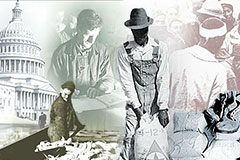


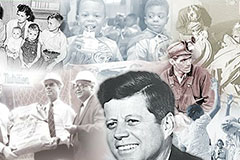






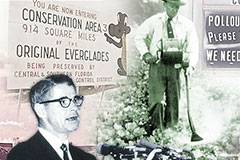




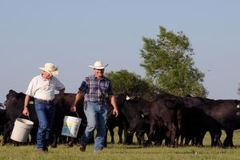











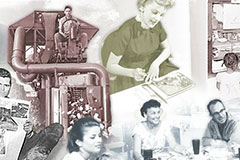


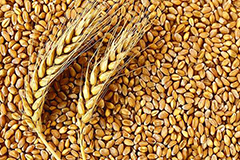

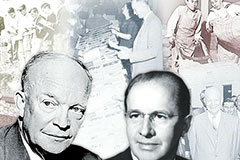




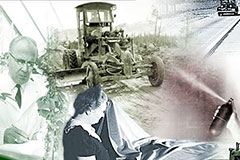








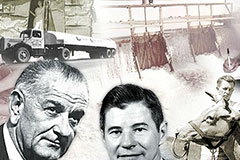

















What would you like to find?

Downloadable Media: Prosperity and Challenges
Imagery





















Video

More Milk For Children

Screwworms

Caesar Chavez

Farmer For The World
Audio






































At the end of World War II, prosperity brought both opportunity and change to American agriculture. The Marshall Plan was enacted, which helped U.S. farm exports skyrocket from around two billion dollars in the 1940s to nearly four billion in 1950. The Marshall Plan helped restore the European economy while feeding millions of people. American farmers prospered due to record agricultural production and prices. By the late 1940’s, President Harry S. Truman could honestly say, "The American farmer has reached an economic position better than he had ever known before."
Life in the United States changed. A higher standard of living increased home and car ownership and brought more educational opportunities for many Americans. A whole new economy based on consumerism was created as television images increased the public's appetite for all kinds of new products.
Science and technology were changing the way America farmed. Farms became mechanized, and new pesticides, weed killers and chemical fertilizers increased crop yields.
As agriculture became more efficient there were fewer but much larger farms. Fewer people were needed to work on farms, and many families were free to pursue new dreams; so they left the countryside for work in the city and homes in the suburbs.
How would American agriculture cope with the changes prosperity brought after World War II? How would progress in agricultural science change America and the world? Consider these and other questions as you explore, "Growing a Nation: Prosperity and Challenges".
In the 1950s the average total U.S. population: 151,132,000; farm population: 25,058,000; farmers 12.2% of labor force; Number of farms: 5,388,000; average acres: 216; irrigated acres: 25,634,869. It takes 6 1/2 labor-hours required to produce 100 bushels (4 acres) of wheat with tractor, 10- foot plow, 12-foot row weeder, harrow, 14-foot drill, self-propelled combine and trucks. One farmer supplies food and fiber for 15.5 people.
In the 1960s the average total U.S. population: 180,007,000; farm population: 15,635,000; farmers 8.3% of labor force; number of farms: 3,711,000; average acres farmed: 303; irrigated acres: 33,829,000. It takes 5 labor-hours to produce 100 pounds (1/5 acre) of lint cotton with tractor, 2-row stalk cutter, 14-foot disk, 4-row bedder, planter, cultivator, and 2-row harvester; 5 labor-hours required to produce 100 bushels (3 acres) of wheat with tractor, 12- foot plow, 14-foot drill, 14-foot self-propelled combine, and trucks; 99% of sugar beets harvested mechanically (1965). Federal loans and grants for water/sewer systems become common investments for farmers. One farmer supplies food and fiber for 25.8 people.
As the U.S. population continues to grow the farm population shrinks. How do fewer farmers continue to feed a growing population?
At the end of World War II, prosperity brought both opportunity and change to American agriculture. The Marshall Plan was enacted, which helped U.S. farm exports skyrocket from around two billion dollars in the 1940s to nearly four billion in 1950. The Marshall Plan helped restore the European economy while feeding millions of people. American farmers prospered due to record agricultural production and prices. By the late 1940’s, President Harry S. Truman could honestly say, "The American farmer has reached an economic position better than he had ever known before."

Harry S. Truman
On April 12, 1945, following the death of President Franklin D. Roosevelt and after having served only a few months as Vice President, Harry S. Truman became the thirty-third President of the United States. Visit the White House website to learn more about the life of this decisive leader in American history, and then answer the following questions.
Questions
How would you have felt if you were thrust into the office of president like Truman?
What do you think were the most important decisions made by Truman during his presidency?

Emergency Food Assistance
With the end of World War II in Europe on May 8, 1945, came the realization of the devastation the war had brought to both the people and the land. Many countries faced food shortages in the years following the war. America's food and agricultural system rose to the challenge and helped supply Europe with emergency food assistance.
"Food production declined during 1945-46 in Europe and North Africa because of drought and difficulties resulting from the war. . . . It became obvious [to the USDA] that grain was the best immediate answer to needs abroad. On February 6, 1946, [President Truman] announced the following nine emergency measures to meet the needs.
"1. A vigorous campaign to secure the cooperation of consumers, bakers and retailers in conservation of food, with particular emphasis on bread
2. Discontinuance of the use of wheat in the direct production of alcohol and beer and limitation of the use of other grains for production of . . . alcohol and beer
3. An increase in the wheat flour extraction rate to 80 percent
4. Control of wheat and flour inventories
5. Giving the shipment of essential foods preference in rail use
6. Direct Government control over exports of wheat and flour
7. The export during the calendar year of 375,000 tons of fats and oils, 1.6 billion pounds of meat, and increased quantities of dairy products
8. Release of ships for the movement of food to Europe
9. Development of ways of conserving grain being fed to livestock and poultry for use as human food."
Questions
Why did the United States send relief food and supplies to its former enemies?
If you were President of the United States during this time, how would you have answered the world's call for postwar relief?
Does the United States continue to assist war-torn nations today? Why?
G. Baker, J. Porter, W. Rasmussen, and V. Wiser, eds., Century of Service: The First 100 Years of the United States Department of Agriculture (Washington, D.C.: Centennial Committee, U.S. Department of Agriculture, 1963).

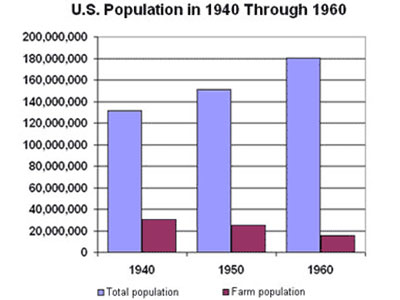
U.S. Population in 1940 Through 1960
The population of the United States increased by 20 million between 1940 and 1950. This decade also saw a decrease of nearly 5 million farmers and 700,000 farms. These changes are charted in the above graph.
Questions
Why was the farm population decreasing during these years?
How was America able to continue feeding itself and much of the world while having fewer and fewer farms and farmers?
History of American Agriculture, 1607-2000, U.S. Department of Agriculture [online].
After World War II a higher standard of living increased home and car ownership and brought more educational opportunities for many Americans. A whole new economy based on consumerism was created as television images increased the public’s appetite for all kinds of new products. Science and technology were changing the way America farmed. Farms became mechanized and new pesticides, weed killers and chemical fertilizers increased crop yields. As agriculture became more efficient there were fewer but much larger farms. Fewer people were needed to work on farms, and many families were free to pursue new dreams; so they left the countryside for work in the city and homes in the suburbs.

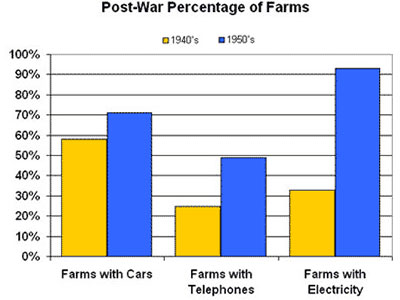
Post-War Percentage of Farms
The United States experienced an economic boom after World War II. The above graph illustrates some of the changes that occurred on farms during the 1940s and 1950s, using the number of cars, telephones, and homes with electricity to measure the standard of living.
Questions
With all the aid that the United States was sending overseas, how is it that the standard of living for farmers was increasing so rapidly?
How would life on the farm change with electricity?
Was electricity a luxury or a necessity for farmers?
History of American Agriculture, 1607-2000, U.S. Department of Agriculture [online].

Television in America
In the 1950s, television became widely accepted as a news and entertainment medium in the United States. Visit this historical timeline on the Evolution of the Television to consider televisions impacts.
Questions
What influence has television had on American culture and economy related to food and agriculture?


In 1950, Communist North Korea invaded South Korea. Once again the United States re-armed, with agriculture playing a fundamental role. The U.S. military and Korean civilians needed new food supplies. In July, 1950 President Truman ordered the U.S. Department of Agriculture to increase agricultural production for the war. Part of the push to re-arm required farmers to increase or decrease production of specific farm products, a course of action that World War II practices had already prepared them to accept. The American public was again asked to conserve food supplies by growing gardens at home. The war became an economic boom for farmers who had crops to sell and families to support.
The USDA also stepped up research during the war, in order to assist the military in solving the scores of new problems brought on by modern warfare. New fabrics were developed to help shield soldiers from burns, and to help protect wounds from infection. Dextran, a sugar produced from bacteria acting on cane or beet sugars, was developed to assist blood transfusions. The USDA's civilian research programs also continued during the 1950s. Their work dramatically improved the flavor and stability of soybean oil, making this once insignificant crop one of America's most important products. Agricultural research increasingly made invaluable contributions to modern society.
In 1950, Communist North Korea invaded South Korea. Once again the United States re-armed, with agriculture playing a fundamental role. The U.S. military and Korean civilians needed new food supplies. In July, 1950 President Truman ordered the U.S. Department of Agriculture to increase agricultural production for the war. Part of the push to re-arm required farmers to increase or decrease production of specific farm products, a course of action that World War II practices had already prepared them to accept. The American public was again asked to conserve food supplies by growing gardens at home.

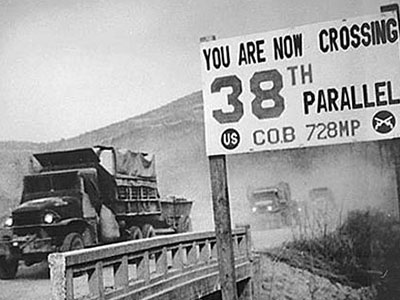
The Invasion of the Republic of Korea
"On June 25, 1950, the Republic of Korea was invaded by armed forces from Communist North Korea. The United Nations promptly went to the aid of the invaded nation. Although several countries supported the United Nations with troops and equipment, the major fighting force and its supplies came from the United States. For the next 3 years, this war influenced every aspect of American life, including agriculture.
"On July 21, 1950, the President asked the Secretary of Agriculture and other agency heads to undertake a detailed review of programs with a view to lessening the demand upon services, commodities, raw materials, manpower, and facilities in competition with those needed for national defense. One result of the President's request was that steps were taken in the farm housing program to curtail the use of building materials for non-defense purposes and to prevent Government loans from adding to inflationary pressures."
Questions
What was the cause of U.S. involvement in the Korean War?
Why did member countries of the United Nations also become involved?
G. Baker, J. Porter, W. Rasmussen, and V. Wiser, eds., Century of Service: The First 100 Years of the United States Department of Agriculture (Washington, D.C.: Centennial Committee, U.S. Department of Agriculture, 1963).

Fertilizer Increases Crop Yields
"The Department of Agriculture has estimated that increased use of fertilizers accounted for 55 percent of the productivity gains per crop acre that occurred from 1940 to 1955. These triumphs of fertilizer and of other technological improvements had an ironic result. They created huge price-depressing surpluses, which by the 1950s, in combination with insufficient migration from the farm, impoverished large portions of rural America. Only the famine in Europe and the Korean War saved the farmer from depression in the Truman Years."
Questions
What were the positive and negative results of fertilizer use in the 1950s?
What are the benefits and challenges posed by other research innovations?
Do new inventions solve the problems for which they are introduced?
Allen J. Matuson, Farm Policies and Politics in the Truman Years (New York: Atheneum, 1970).

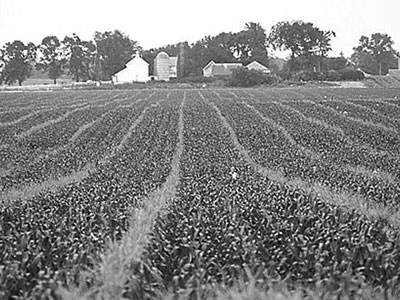
Research Into Crop Rotation
Agricultural research into the benefits gained from the practice of crop and pasture rotation has proven to be one of the most important ways USDA research has improved agriculture. Researchers proved that rotation helped produce more abundant grasses and crops. The process involved planting corn the first year and wheat the second year, followed by three years of pasture and hay crops. Fields that were rotated yielded 11 percent more crops.
Questions
Why does this process help create better crop yields? What purpose does it serve in helping crops to grow?
Walter Yust, ed., 1954 Britannica Book of the Year (Encyclopedia Britannica, 1954).
The USDA also stepped up research during the war, in order to assist the military in solving the scores of new problems brought on by modern warfare. New fabrics were developed to help shield soldiers from burns, and to help protect wounds from infection. Dextran, a sugar produced from bacteria acting on cane or beet sugars, was developed to assist blood transfusions. The USDA’s civilian research programs also continued during the 1950s. Their work dramatically improved the flavor and stability of soybean oil, making this once insignificant crop one of America’s most important products. Agricultural research increasingly made invaluable contributions to modern society.

Soybeans
Soybeans provide a wide variety of products for human use. Their development has led to new food products, clothing, cosmetics, and more. Visit the Agricultural Research Service website to learn more about products that are made better with soybeans.
Questions
Do any of the products listed come as a surprise to you? What is it about soybeans that makes them so useful? Is it their flavor? Texture? Consistency?


Dextran
Dextran is a substance derived from corn that can be used as a replacement for blood plasma. It was first used during the Korean War, when plasma was in short supply. Dextran offered several advantages over plasma: it could be sterilized, and it could be kept longer without refrigeration. It's also cheaper than plasma and is derived from cane or beet sugar instead of coming from human blood donors. Agricultural Research Service (ARS) scientists at the Northern Regional Research Lab in Peoria, Illinois, discovered a way to economically produce dextran in the necessary quantities. The military began using it in 1950, and it was approved for civilian use in 1953. Dextran is still used today.
Questions
Why are many important discoveries made during wartime?
What are some of the discoveries that have been made as a result of more recent wars?
Why does the USDA place a heavy emphasis on research?
ARS Timeline: 138 Years of Ag Research, U.S. Department of Agriculture [online].


Farms changed considerably during the Fifties. In 1950 the average farm was two hundred and thirteen acres; by 1960 it was two hundred and ninety-seven acres and growing. The number of large-scale commercial farms continued to increase because they were more efficient and productive. Modernization, such as the introduction of the mechanical cottonpicker and the mechanized processing of peas from vine to freezer, became the goal of many producers and processors in the United State's rapidly shifting agricultural economy. Farmers who owned smaller farms had to seek extra income from other employment, or form "cooperatives" to compete with large-scale commercial agricultural enterprises.
American eating habits changed along with American lifestyles. In 1954 T.V. dinners were introduced and became an instant success. Fast food restaurants became popular after the first McDonalds franchise was bought in 1955. More and more prepared foods entered the marketplace while supermarkets began to replace the corner grocery store. The frozen food industry boomed as Americans bought larger refrigerator freezers and sought more convienience foods. The number of working wives increased by fifty percent during the 1950s, and the percentage of working women with children also rose. Food preparation needed to be quick and simple for the new American family. Improvements in refrigeration, transportation and processing enabled Americans to enjoy a wide variety of foods while spending less of their income on food than ever before.
Farms changed considerably during the Fifties. In 1950 the average farm was two hundred and thirteen acres; by 1960 it was two hundred and ninety-seven acres and growing. The number of large-scale commercial farms continued to increase because they were more efficient and productive. Modernization, such as the introduction of the mechanical cotton picker and the mechanized processing of peas from vine to freezer, became the goal of many producers and processors in the United States rapidly shifting agricultural economy. Farmers who owned smaller farms had to seek extra income from other employment, or form "cooperatives" to compete with large-scale commercial agriculture enterprises.


Cost to Farm
Owning a farm in the 1950s was becoming expensive. In 1940, it cost around $6,622 per year to keep a farm running; in 1952, it was $23,027.
Questions
Inflation is one cause of rising prices, but what may some of the other factors have been?
Why did farm expenses rise so quickly in this short period of time?
Harold D. Guither, Heritage of Plenty: A Guide to Economic History and Development of U.S. Agriculture (Danville, Ill.: Interstate, 1972).

Farmer Cooperatives
Farmer cooperatives have long been a way for farmers to band together to improve their economic conditions. Farmers can cooperate to maximize their purchasing power, obtain credit, market their products, and lobby for political change. Visit the National Council of Farmer Cooperatives website to learn how cooperatives help to increase farm wealth.
Questions
How did cooperatives in the 1950s gain competitive power?
If you were a small farmer, would it be hard to compete against a cooperative?

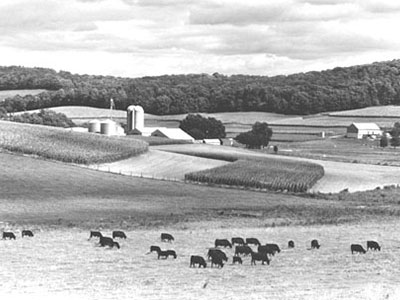
Bigger and Bigger Farms
Throughout rural America, modern, mechanized, commercial farms were better able to maximize the economies of scale that the new and expensive technologies offered, and they began to replace smaller, family-owned farms. Cooperatives between smaller farms were one way these farmers could compete in the emerging commercialized farm economy. Cooperatives allowed members to pool resources to jointly buy new machinery and to market their products as a group.
Questions
What advantages did large farms have over small farms?
How do these advantages reflect the current practices of farming corporations?
For most of its history, the word "breadbasket" was tied to the consumption of food, referring since the early 1700s to one's stomach or belly. Not until after World War II did the word's slang usage switch to the production side of the food story. By the end of the twentieth century "breadbasket" was widely used to describe a significant grain-growing region, with the Great Plains. Despite frequent calls for greater diversification, wheat was the preferred crop. Relatively cheap and easy to grow and readily transportable to distant markets, wheat offered quick returns and desperately needed cash flow to debt-strapped farmers.


The Nation's Breadbasket
The Great Plains (Colorado, Iowa, Kansas, Minnesota, Montana, Nebraska, New Mexico, North Dakota, Oklahoma, South Dakota, Texas, and Wyoming) area has some of the best farmland in our nation, with rich, productive soil and a favorable climate. After the adoption of the Homestead Act, settlers began moving into this area, and by the late 1800s the average size farm in this region was nearly 150 acres. View this video to learn more about Kansas, one of the Breadbasket (Great Plains) states.
Questions
Why is this area called "America's breadbasket"?
Are there other areas in the world that are equally productive?
What parts do soil and climate play in making this area the breadbasket?
North American Bread basket (map), Harper College, Palatine, Illinois [online]; and History of American Agriculture, 16072000, U.S. Department of Agriculture [online].

Soils in America
Soil is the medium for growing America’s plants. Many regions of the country have land with good soil for growing healthy crops, while other areas have less productive soil. Each state has chosen one kind of representative soil to be its “state soil.” Go to the USDA Natural Resources Conservation Service’s website on State Soils. Using the links you find, examine the state soil of your state and other states.
Questions
How does your state’s soil compare to the soils in other states?
Overall, what do you think of the quality of the soils in the United States?
What effect do you think soil quality has on the growth and economy of a nation?

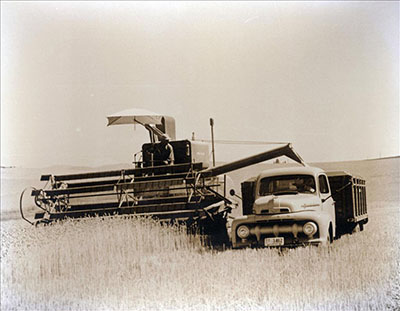
Seed to Shelf
In the North American plains, the wheat production axis that extends over a length of 1,500 miles in a north–south direction from central Alberta to central Texas is known as the Wheat Belt. Hard red winter wheat is grown in the southern U.S. states of Kansas, Oklahoma, Texas, Nebraska, and Colorado. In the hot climatic conditions of these states, winter wheat is raised by planting in fall and harvesting in the spring, taking advantage of autumn rains. Under harsh cold weather conditions in parts of Montana, North Dakota, South Dakota, and Minnesota where winter wheat cannot be grown, the crop is planted in the spring and grows during the long summer days of the high latitudes so that it can be harvested in the fall.
In the 1800s, wheat was cut with a "wheat cradler" (a skilled cradler could harvest 1 ½ -2 acres a day), and then the wheat stems (which become straw) would be bundled and then threshed with a flail. A flail has a long handle connected to a short heavy club with a flexible joint. It is used to break the seed heads apart.
McCormick's mechanical reaper (1831) was a horse-drawn machine that could harvest 10-12 acres a day. In the 1880’s, a knotting device was added to the reaper to tie the bundles of grain automatically, eliminating the tedious hand tying. the harvesting of wheat was done by hand. Machine size grew to where as many as 30 mules were needed to pull a combine!
As seed varieties improved, and acres planted increased, better harvesting equipment was needed. A variety of machines were created to cut (reap), thresh (remove the seeds from the stem, and winnow (remove the chaff from the wheat seed or kernel). The modern combine, that combined all these tasks with the use of a tractor, was developed in the early 1900s.
View "A Brief History of the Combine" to see the evolution of combines.
Questions
How would an innovation like the combine impact production, labor, and the cost of producing wheat?
https://www.lhf.org/2015/07/grain-harvest-and-threshing-time/
American eating habits changed along with American lifestyles. In 1954 T.V. dinners were introduced and became an instant success. Fast food restaurants became popular after the first McDonald's franchise was bought in 1955. More and more prepared foods entered the marketplace while supermarkets began to replace the corner grocery store. The frozen food industry boomed as Americans bought larger refrigerator freezers and sought more convenience foods.

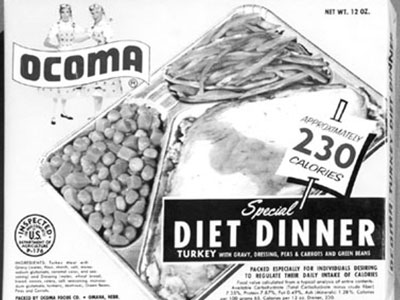
TV Dinner
The 1950s ushered in a new era of consumerism. New and improved products of all kinds promised to make life easier for consumers. Frozen dinners and other convenience foods were gaining in popularity as more women took on jobs outside the home.
From 1948 to1965, USDA scientists worked with the frozen food industry to improve the quality of the products. USDA research focused on how time and temperature affected various frozen foods in terms of quality and stability. The work of the USDA scientists helped greatly improve the quality of frozen foods and boosted this multibillion-dollar industry.
Questions
What social factors were playing a part in more women joining the workforce?
How do you think communication technologies such as television might have played a role?
National Agricultural Library [online].

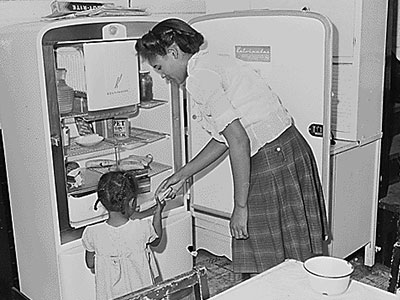
Working Women
The number of working wives increased by fifty percent during the 1950s, and the percentage of working women with children also rose. Food preparation needed to be quick and simple for the new American family. Improvements in refrigeration, transportation, and processing enabled Americans to enjoy a wide variety of foods while spending less of their income on food than ever before.
Questions
What are both the benefits and the downfalls of these new technologies in food preparation for this time period?
Looking at the technological advancements during this time, how do they compare and contrast to new technologies in food preparation today in the 21st century?
How did these technological advancements change the dynamics of meal preparation and meal time for families and individuals change during this time period?


When President Dwight D. Eisenhower took office in 1953 he believed that government had imposed too many rigid federal controls on farmers that bottlenecked the flow of business, and took away competition in agriculture. Under the leadership of Eisenhower’s Secretary of Agriculture, Ezra Taft Benson, the USDA reorganized to meet the changing needs of American agriculture. Benson believed that adequate research and education programs in the production, processing, marketing and utilization of farm products were the best means of promoting the welfare of farmers and the nation.
When the Korean War ended, in July 1953, surpluses caused dramatic price drops for farm products. The federal government established programs to encourage farmers to produce less once again, and worked to develop new markets for agricultural products.
In 1953 the USDA established the Agricultural Marketing Service to seek solutions to the problems of surpluses and help "bring consumers adequate supplies of wholesome farm products at reasonable prices." This service worked to improve the packing of perishable fruits and vegetables, establish better warehousing and food storage systems, and develop new terminal facilities in large cities; all to save both growers and the public money and improve the quality of America's foods.
When President Dwight D. Eisenhower took office in 1953 he believed that government had imposed too many rigid federal controls on farmers that bottlenecked the flow of business, and took away competition in agriculture.

Ezra Taft Benson
Ezra Taft Benson served as the U.S. Secretary of Agriculture during the Eisenhower administration. Watch this film to learn his views on how to make American agriculture successful.
Questions
Why is Secretary Benson optimistic about the future of American agriculture?
What does he say can help farmers be more prosperous?
What does Benson think are the important qualities of American farmers?
Do you think agriculture has an effect on the peace and prosperity of nations? Why or why not?
Film - Secretary Benson's New Year Message, 1955, courtesy of U.S. National Archives and Records Administration.

Differences Between the US and Russia During the Cold War
Ezra Taft Benson, Secretary of Agriculture from 1953 to 1960, described some of the differences between the United States and Russia during the Cold War:
"In Russia some 48 million persons are working in agriculture--about 45 percent of their total labor force compared with ten percent in the United States. Yet they worry about scarcities while we are concerned with over-abundance."
Questions
What are the primary principles of Communism that produce results such as these?
How does a free market economy promote competition, innovation, and personal wealth?
Ezra Taft Benson, The Red Carpet (Salt Lake City: Bookcraft, 1962).

Motivation in Russia
"Russian farmers didn't have reasonable incentives to work hard or be efficient. Nikita Khrushchev, the communist leader of Russia in the fifties, told a story of meeting a farmer in Russia. He said:
"'Tell me,' I asked, 'what's your best crop here?'
"'Oats.'
"I couldn't believe my ears. I knew that the soil on this collective farm was so sandy it was barely arable. 'Are you trying to tell me you get high yield of oats around here?'
"'No, we get a very low yield.'
"'Then why do you say oats is your best crop?'
"'Because it's the easiest to harvest.'
"This man's cynicism stemmed from a lack of material incentive. His salary was completely independent of how much his farm produced."
Questions
How is farming in America different?
What incentives did a farmer have for producing more commodities?
What motivates farmers to continue to improve their livelihood?
Nikita Khrushchev, Khrushchev Remembers: The Last Testament (Boston: Little, Brown, 1974).
Dwight D. Eisenhower like all presidents, create programs and policies that continue to influence the lives of Americans and others around the world.

Dwight D. Eisenhower
Dwight D. Eisenhower took the oath of office as the thirty-fourth American President in January of 1953. He brought with him the tremendous stature and leadership skills he had earned as the former Supreme Commander of the Allied Forces in Europe during World War II. Visit the White House’s website to read his brief biography, then answer the following questions.
Questions
What was President Eisenhower’s campaign slogan?
Why did it appeal to most Americans?
How do you think President Eisenhower’s former career as a professional soldier contributed to his success as President?

Agricultural Marketing Service
In 1953 the USDA established the Agricultural Marketing Service to seek solutions to the problems of surpluses and help “bring consumers adequate supplies of wholesome farm products at reasonable prices.” This service worked to improve the packing of perishable fruits and vegetables, establish better warehousing and food storage systems, and develop new terminal facilities in large cities; all to save both growers and the public money and improve the quality of America’s foods.
Questions
Looking at the goals of the Agricultural Marketing Service, what do you think the overall benefits of these goals are for the consumers of agricultural goods during this time period?
Why might have it been important to create terminal facilities in large cities? In your response please include your ideas surrounding giving urban dwellers access to agricultural goods.

More Milk For Children
Milk has been offered as part of school lunch programs since 1946. Watch this film to learn more about the government's efforts to increase milk consumption.
Questions
Who do you think is the audience for this film?
What are the similarities and differences between school age children in the early '50s and now, as apparent from this film?
Why have the government and nutritionists encouraged people, especially children, to drink more milk?
How did milk surpluses affect this program?
How often do you get milk at school? May you take more than one?
Film - More Milk for More Children, undated, courtesy of U.S. National Archives and Records Administration.


National Highway System
People traveling in the United States today may find it difficult to imagine our country without the Dwight D. Eisenhower System of Interstate and Defense Highways.
Our national highway system came about largely due to the efforts of President Eisenhower. As a young army officer, Eisenhower traveled cross-country during the 1919 Transcontinental Convoy, where he first saw the need and potential advantages of an interstate road system.
Later, when Eisenhower served as Supreme Commander of Allied Forces in Europe during World War II, he was impressed by the ease of travel on the German autobahn highway system. He saw the benefits a multilane highway system would have in building a strong national defense. As President, Eisenhower signed the Federal Aid Highway Act on June 29, 1956, which created the interstate system we rely on today.
Questions
How did the building of interstate highways help unite the country?
What value does America's freeway system add to the nation? To the economy?
"Federal-Aid Highway Act of 1956," The Eisenhower Birthplace State Historic Site [online].
With the end of the Korean War came new farm bills to assist the United States government in dealing with a surplus of commodities such as corn, cotton, and wheat. Both the Agricultural Act of 1954 and the Agricultural Act of 1956 dealt with issues with supply and demand that lingered following the boom in production surrounding the Korean War.

The Agricultural Act of 1954
With the Korean War ending in 1953, the technology coming from the war had an impact on the agricultural industry. Technological advances assisted in boosting crop yields and farm productivity leading to massive surpluses of crops such as corn, cotton, and wheat. With the end of the war came a fall in demand for crops which was coupled with high, fixed loan rate policies. President Eisenhower and Congress worked to control this surplus by creating legislation called Food for Peace, a program that allowed surplus crops to be given as foreign food aid to United States’ allies. Food for Peace still exists today.
One issue in the Agricultural Act of 1954 that became rather contentious was loan rates during this time period. Some legislators believed that the rate should stay at 90% parity or equivalence while other legislators and the president believed that the rate should be lowed to allow farmers more flexibility. Within the 1954 farm bill there was the first step away from 90% parity. Farmers were not happy with this decision because prices within the United States economy soared in the post-war times while farmers were receiving low prices for their crops due to supply and demand. This issue lead to a shift in power in the mid-term elections when farmers returned Democrats to power in the House of Representatives.
Questions
What role did supply and demand play in the Agricultural Act of 1954?
In addition to the creation of the program Food for Peace, what other strategies might the government and farmers employ to deal with the surplus of crops following the end of the Korean War?
Coppess, J. (2017). Reviewing farm bill history: The agricultural act of 1954. Farmdocdaily, (7)29.

The Agricultural Act of 1956
It was within the Agricultural Act of 1956 that the Soil Bank Program or Title I: Soil Bank Act was created. This act assisted in addressing the surplus of crops resulting from the end of the Korean War. The Soil Bank Act allowed farmers to remove land from production in exchange for rental payments. This program was called the Acreage Reserve Program and included wheat, corn, rice, cotton, peanuts, and several types of tobacco. Under the Conservation Reserve Program, farmers were allowed to retire land for three, five, or 10 years in exchange for annual payments. The Soil Bank Act was active until 1965 when it was repealed by the Food and Agricultural Act of 1965.
Questions
How would retiring and/or not planting fields in exchange for payments help to control the supply and demand issues that existed from the Agricultural Act of 1954?
Why do you think that the Soil Bank Act was repealed and or taken away in the 1965 farm bill?
What might the positives and/or negatives of the repealing of the Soil Bank Act be for farmers, the government, and the economy?
H.R. 10875 (84th): An Act to enact the Agricultural Act of 1956. (2018). Wikipedias summary.


The changes in agriculture during the 1950s were not brought about by government policy alone. In 1953, the USDA established the Agricultural Research Service to focus its research efforts on a national scale.
Agricultural scientists were busy developing better breeds of plants and animals, and new techniqes to stop insects from destroying entire crops. Research conducted by Edward F. Knipling of the USDA, using the sterile insect technique (a method of biological control) led to the eventual eradication of the screwworm, a parasite that had caused severe losses of livestock for many years. Time-temperature research by USDA scientists during the Fifties also solved numerous frozen food taste and quality problems, and helped the new industry boom. In addition, USDA scientists developed new products such as washable woolens, new cotton fabrics and better methods for making leather goods. USDA scientists also developed DEET, a widely used and highly effective insect repellent, for the Armed Forces.
In 1954 American agriculture passed a technological milestone when the number of tractors on farms exceeded the number of horses and mules for the first time. In 1956 an Interstate Highway Act was passed to build modern freeways across the nation, which made it faster and easier for people to travel and to ship agricultural products across America.
In 1953, the USDA established the Agricultural Research Service to focus its research efforts on a national scale.

Biological Controls
Agricultural scientists were busy developing better breeds of plants and animals, and new techniques to stop insects from destroying entire crops. Research conducted by Edward F. Knipling of the USDA, using the sterile insect technique (a method of biological control) led to the eventual eradication of the screwworm, a parasite that had caused severe losses of livestock for many years. USDA scientists also developed DEET, a widely used and highly effective insect repellant, for the Armed Forces.
Questions
What is the purpose of this film?
Why was it important to eliminate the screwworm in America?
Are invasive species a problem today?
Text adapted from USDA APHIS News and Info: Screwworm, February 2002 (online); film The Screwworm, excerpt 2, c. 1975, courtesy of U.S. Department of Agriculture and Agricultural Research Service, available on CD-ROM STOP Screwworms: Selections from the S

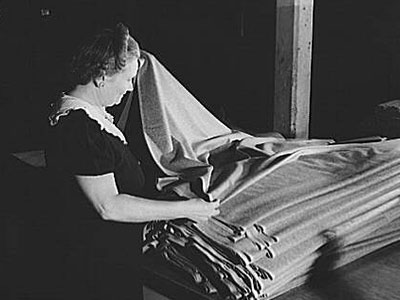
New Products From The USDA
USDA scientists developed new products such as washable woolens, new cotton fabrics and better methods for making leather goods.
Questions
Looking at the new materials developed by the USDA scientists, what industries and products might have been impacted and/or changed by these new products?


Number of Tractors
In 1954 American agriculture passed a technological milestone when the number of tractors on farms exceeded the number of horses and mules for the first time.
Questions
With tractor usage on the rise, what are the implications of these technological advancements on daily life for farmers?
What are the implications both positive and negative of the use of the tractor on the environment?


Interstate Highway Act
In 1956 an Interstate Highway Act was passed to build modern freeways across the nation, which made it faster and easier for people to travel and to ship agricultural products across America.
Questions
Why might producers of agricultural products want to ship their goods quickly across the country to the consumer?
What are the environmental impacts of an interstate system on air, land, and water quality?

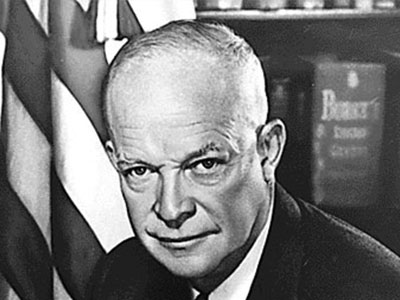
Subsidies
When President Eisenhower was criticized for his farm programs, his brother wrote him a letter, saying, "I am sick of paying the farmer money for his product, wasting that product, and then paying him a higher price for what he puts in the market!" Like many other critics of the government's farm programs, Eisenhower's brother argued that Americans were basically paying farmers to overproduce and then further subsidizing farmers by paying artificially high prices instead of letting supply and demand determine the price of farm products.
Questions
What was the purpose of the government's active support of farming?
How does this role affect those who don't live in rural areas?
Is it possible that the government helps farmers too much? Not enough?
Dwight D. Eisenhower, The White House Years: Mandate for Change, 1953-1956 (Garden City, N.Y.: Doubleday, 1963).
Public Law 480, The Food-For-Peace program, was created in 1954 to help use the surpluses resulting from the great increases in agricultural productivity. This program authorized the USDA to buy surplus U.S. farm products

Public Law 480
The United States has a long history of providing emergency food assistance to foreign countries following natural disasters and wartime famines. In 1954, President Eisenhower laid the foundation for a permanent U.S. food assistance program by signing Public Law 480 into law. This law, still in effect today, allows the government to send American farm surpluses abroad to help countries facing food shortages. President Eisenhower said, "Food can be a powerful instrument for all the free world in building a durable peace."
Questions
Do you think food relief can enhance the possibilities for world peace?
What events demonstrate that violence can occur when food is scarce?
Do other countries provide aid to less fortunate countries?
Celebrating Food for Peace, 1954-2004, U.S. Agency for International Development [online].


As the 1950s drew to a close, a revolution in American agriculture was in full bloom. Low cost fertilizers, such as anhydrous ammonia, were widely used to renew the nutrients in exhausted soil. New pesticides and herbicides also led to even greater increases in farm productivity. By 1960 a farmer could produce sixty bushels of corn per acre, compared to only thirty bushels of corn per acre in the late 1940s. By 1961 one farmer could feed twenty-seven people, compared to feeding only eleven people in 1940.
Public Law 480, The Food-For-Peace program, was created in 1954 to help use the surpluses resulting from the great increases in agricultural productivity. This program authorized the USDA to buy surplus U.S. farm products for distribution to countries struggling to feed their own people. American farmers benefited from the increased exports while thousands of people in recipient countries were saved from hunger.
As fewer people were working on farms in rural America, the federal government began a rural development program to bring together the resources of the USDA, other government agencies and private enterprise to help diversify rural economies. This program provided more opportunities for job training and promoted the development of business and industry outside of cities.
Low cost fertilizers, such as anhydrous ammonia, were widely used to renew the nutrients in exhausted soil. New pesticides and herbicides also led to even greater increases in farm productivity. By 1960 a farmer could produce sixty bushels of corn per acre, compared to only thirty bushels of corn per acre in the late 1940s. By 1961 one farmer could feed twenty-seven people, compared to feeding only eleven people in 1940.

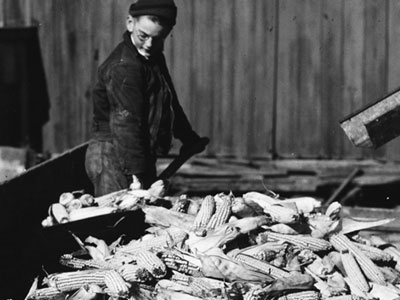
More Corn Per Acre
By 1960 a farmer could produce sixty bushels of corn per acre, compared to only thirty bushels of corn per acre in the late 1940s. By 1961 one farmer could feed twenty-seven people, compared to feeding only eleven people in 1940.
Questions
How might the productivity increases in corn affect the price of corn?
How would increases in crop yields affect the number of farmers needed to grow crops?


When President John F. Kennedy was elected in 1960, he promised a broader government role in rural America. By then the definition of rural populations had expanded beyond people involved in agriculture to include those working in manufacturing, mining, or recreation; retirees, college students; and military personnel stationed at military bases in rural areas. The exodus of people from rural America that began after World War II continued during the 1960s and added to the unemployment, congestion, and poverty of inner city America. However, the rural poor were often worse off than the urban poor since they had less access to social programs aimed at alleviating property.
President Kennedy felt obligated to reach out to the rural poor and to help small-scale farmers. He guaranteed price supports again, reversing the trend toward free market government policy. Direct federal payments to farmers between 1959 and 1962 more than doubled, to $1.7 billion dollars. One of Kennedy's first acts as President was the expansion of food programs to assist needy families throughout the United States. Using the model of programs from the 1930s, the USDA expanded the school milk program and piloted a new Food Stamp Program to use America's abundance. The Food-For-Peace program was also expanded to distribute agricultural surpluses abroad. Through this program, surpluses went to even more third world nations in order to help them develop, and to increase America's influence in the world. Speaking of America's agricultural abundance, Kennedy said, "I don't regard the agricultural surplus as a problem. I regard it as an opportunity."
When President John F. Kennedy was elected in 1960, he promised a broader government role in rural America. By then the definition of rural populations had expanded beyond people involved in agriculture to include those working in manufacturing, mining, or recreation; retirees; college students; and military personnel stationed at military bases in rural areas.

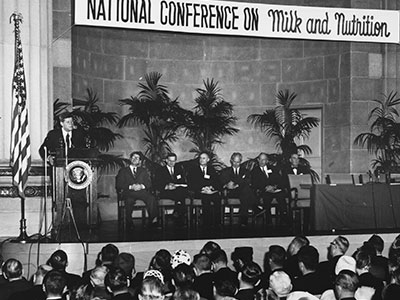
At the National Milk Conference
President Kennedy felt obligated to reach out to the rural poor and to help small-scale farmers. He guaranteed price supports again, reversing the trend toward free market government policy. Direct federal payments to farmers between 1959 and 1962 more than doubled, to $1.7 billion dollars. One of Kennedy’s first acts as president was the expansion of food programs to assist needy families throughout the United States. Using the model of programs from the 1930s, the USDA expanded the school milk program and piloted a new Food Stamp Program to use America’s farm abundance.
Questions
Why do you think that President Kennedy modeled his programs for low income Americans after the programs of the 1930s?
What is the rationale behind creating a new Food Stamp Program that uses America's farm abundance and surplus?

Using Food Stamps
Below is a list of the things food stamp recipients may or may not buy using food stamps. Households may use food stamp benefits to buy foods for the household to eat, such as:
--breads and cereals
--fruits and vegetables
--meats, fish, and poultry
--dairy products
--seeds and plants that produce food for the household to eat.
Households may not use food stamp benefits to buy:
--beer, wine, liquor, cigarettes, or tobacco
--pet foods
--soaps, paper products, and household supplies
--vitamins and medicines
--food that will be eaten in the store
--hot foods.
Questions
How do you think the USDA determined which products would be eligible for purchase through the food stamp program?
Do you think that all foods should be eligible for purchase through the program? Why or why not?
"Food Stamp Program: Frequently Asked Questions," Food and Nutrition Service, U.S. Department of Agriculture [online].

School Lunches
Watch this film to learn more about the school lunch program in the "space age."
Questions
Why do you think the USDA and Congress created the school lunch program?
How does the program affect American agriculture, the economy, and nutrition?
Would you rather eat school lunch or bring lunch from home?
Film - School Lunch, undated, courtesy of U.S. National Archives and Records Administration.
The Food-For-Peace program was also expanded to distribute agricultural surpluses abroad. Through this program, surpluses went to even more third world nations in order to help them develop, and to increase Americas influence in the world. Speaking of Americas agricultural abundance, Kennedy said, "I don't regard the agricultural surplus as a problem. I regard it as an opportunity."

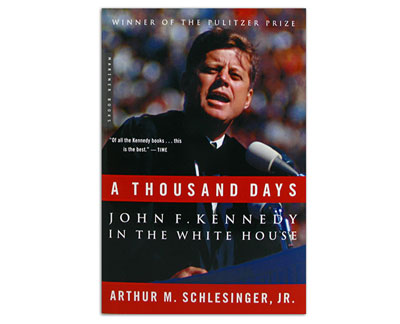
Public Law 480 to Food-For-Peace
President Kennedy renamed Public Law 480 the "Food-for-Peace" program. For more than fifty years, this food assistance program has helped hundreds of countries and hundreds of millions of people in need. One author wrote:
"Shipments under Public Law 480 averaged nearly $1.5 billion annually in the Kennedy years. This assistance not only played a notable humanitarian role in averting mass starvation in India, Egypt, Algeria and other nations but the use of food as wage carried it beyond a relief program to serve, in effect, as a means of financing development."
Questions
How could U.S. agriculture help other countries develop?
How was food used as "wage" in these struggling countries?
Is it right that America provides food to the world?
Arthur M. Schlesinger, Jr., A Thousand Days: John F. Kennedy in the White House (Greenwich, Conn.: Fawcett, 1965).


After President Kennedy was assassinated in November 1963, President Lyndon B. Johnson continued to extend government programs for agriculture, with more food stamp acts and more incentives for farmers to decrease production. He also tried to help farmers by pushing forward a "program to make available our farm surpluses to assist in feeding and clothing the needy in Asia." As it had before, American agriculture helped fight a war: the Vietnam War in Southeast Asia.
At home, President Johnson promoted a program called "The Great Society" to tackle a variety of social issues in America, including the problem of rural poverty. Despite the poverty of the 1960s, many of America’s farming communities could expect a standard of living comparable to that of the nation’s urban dwellers, and better than most farmers could expect almost anywhere else in the world. Secretary of Agriculture Orville Freemen commented that, "America stood above all nations” because of “Scientific Agriculture."
The fruits of research during the 1960s were staggering. USDA research led to the development of new processes such as automated irrigations systems, and new products like permanent press cotton fabrics that could compete with synthetics. A range of crop and livestock diseases were identified, researched and treated. Better breeds of animals, and new plant varieties (including Fortuna wheat, Rainer cherries, Hood strawberries), provided even more abundant and inexpensive food for Americans.
By the end of the decade, advances in transportation and storage, the decentralization of livestock markets and the dominance of supermarkets set the pattern for the future of American agriculture.
President Johnson promoted a program called "The Great Society" to tackle a variety of social issues in America, including the problem of rural poverty. Despite the poverty of the 1960s, many of America's farming communities could expect a standard of living comparable to that of the nations urban dwellers, and better than most farmers could expect almost anywhere else in the world. Secretary of Agriculture Orville Freemen commented that, "America stood above all nations" because of "Scientific Agriculture."


Poverty Rates By Residence
This graph shows that the number of Americans living in poverty is greater in rural areas than in urban areas.
Questions
Why do you think there is more poverty in rural areas than urban areas?
What should or can be done to lessen poverty in rural areas?
Rural Poverty at a Glance, Economic Research Service, U.S. Department of Agriculture [online].

From Revolution to Reconstruction
After visiting the From Revolution to Reconstruction website and reading about President Johnson and the Great Society, answer the following questions.
From Revolution to Reconstruction website
Questions
Why was President Johnson's program called "the Great Society"?
How great was the "Great Society"?

Caesar Chavez
Caesar Chavez (1927-1993) was an American labor leader and civil rights activist with the goal of improving the lives of migrant agricultural workers. Watch this film to learn more about his efforts.
Questions
What made Chavez a good leader?
What problems face immigrant workers today?
What contributions do Mexican immigrants make to our nation and economy?
What are some of the methods immigrants have used to try to improve their conditions?
Film - Vision USA, No. 82, 1979, courtesy of U.S. National Archives and Records Administration.

Orville Freeman
Orville Freeman, Secretary of Agriculture under President Johnson, speaks about hunger in this late 1960s film. Throughout history, many people in developing countries have gone hungry, even while other nations have an agricultural surplus. Many wealthy countries have tried different strategies to help those who are hungry. Watch this film to hear one opinion on how America should help other nations.
Questions
What factors can lead to food shortages?
What role should America play in helping developing nations?
Do you agree or disagree with Secretary Freeman?
Is it better to give people food or to teach them to grow their own?
How does this decision affect the American economy and trade?
Film - War on Hunger, 1968, courtesy of U.S. National Archives and Records Administration.
The fruits of research during the 1960s were staggering. USDA research led to the development of new processes such as automated irrigation systems, and new products like permanent press cotton fabrics that could compete with synthetics. A range of crop and livestock diseases were identified, researched and treated. Better breeds of animals, and new plant varieties (including Fortuna wheat, Rainer cherries, and Hood strawberries), provided even more abundant and inexpensive food for Americans. By the end of the decade, advances in transportation and storage, the decentralization of livestock markets and the dominance of supermarkets set the pattern for the future of American agriculture.


Uses for Cornstarch
"Starch is the main constituent of grain flours, and the most plentiful starch is cornstarch. Although most of the products from corn milling go into food and feed, 4.5 billion pounds of starch are annually produced, largely for nonfood purposes. Of this amount, 3.5 billion pounds are used in the paperboard, paper, and related industries, where starch serves both as an adhesive and a coating.
New uses for cornstarch continue to surprise us. For example, when Agricultural Research Service scientists married starch to a synthetic chemical, they managed to create a product so thirsty, it could absorb hundreds of times its own weight in water. Someone called it SuperSlurper, and the name stuck.
After patents were secured in 1976, SuperSlurper started popping up all over the marketplace. The absorbent compound, which can slurp up to 2,000 times its weight in water, is used as an electrical conductor in batteries. You can find it in fuel filters, baby powders, and wound dressings. Compounds very much like it are now used in disposable diapers and sanitary napkins."
Questions
How has your life been affected by the SuperSlurper invention?
What other agricultural inventions have impacted your life?
ARS Timeline: 138 Years of Ag Research, U.S. Department of Agriculture [online].

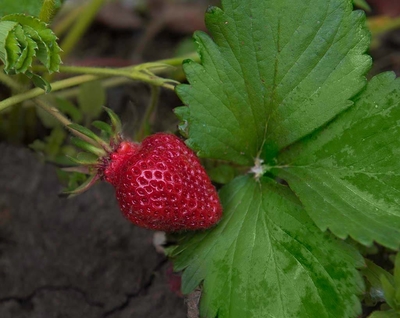
Hood Strawberries
Communication is essential to disseminating research. A press release is an official statement usually delivered to members of the news media for the purpose of providing information, an official statement, or making an announcement. Read the USDA Agricultural Research Service press release to learn more about the uses of the Hood Strawberry and this communication technique.
USDA Agricultural Research Service Hood Strawberry Press Release
Questions
After reading the press release (a primary resource) respond to the following questions:
List three things mentioned that you think is important?
What was the purpose of the press release?
For what audience was the document written?
What are two things the document tells you about life in the United States at the time it was written?
What question do you have that unanswered by the press release?
https://oregon-strawberries.org


American society had benefited greatly from science and technology during the years after World War II. However, during the 1960s people became increasingly aware of the effects of pollution on the environment. In the early 60's, Dr. Rachel Carson condemned the widespread use of chemicals in the environment in her controversial book Silent Spring. Her 1963 testimony before Congress led to dramatic changes in the years ahead. The need to conserve and protect the environment became clearer to the American public.
Public concern for environmental protection brought more changes to American agriculture. In 1967 USDA Secretary Orville Freemen reported that 186 million acres of land were secure in National Forest and Grassland programs, and thirty thousand farmers were using part of their land for income-producing recreation. Farmers had an increased awareness of the need to preserve open spaces and watersheds, and to improve wildlife resources.
By 1970 the environmental movement generated by Dr. Carson's book was in full swing. The Federal government consolidated the functions of various agencies related to pollution and environmental monitoring and protection into one new agency. On December 2, 1970 the Environmental Protection Agency (or EPA) was established. This led to a host of Federal environmental protection acts which addressed the problems of pollution. Following the advice of four government committees looking into pesticide usage, the pesticide DDT was gradually phased out and then banned at the end of 1972. By that time many insects had already become resistant to the chemical and more effective control measures were being developed.
During the 1960s people became increasingly aware of the effects of pollution on the environment. In the early 60's, Dr. Rachel Carson condemned the widespread use of chemicals in the environment in her controversial book Silent Spring. Her 1963 testimony before Congress led to dramatic changes in the years ahead. The need to conserve and protect the environment became clearer to the American public.

Earth Day
The first Earth Day was organized in 1970 as a way to encourage people around the world to celebrate the Earth and to remind all people of their responsibility to care for the Earth. Visit the Earth Day Network website to learn more about this organization.
Questions
How do celebrations such as Earth Day help bring about important change and progress?
What can you do to help protect and conserve the Earth's resources?
On December 2, 1970 the Environmental Protection Agency (or EPA) was established. This led to a host of Federal environmental protection acts which addressed the problems of pollution. Following the advice of four government committees looking into pesticide usage, the pesticide DDT was gradually phased out and then banned at the end of 1972.

Environmental Protection Agency
At the request of President Richard M. Nixon, Congress established the U.S. Environmental Protection Agency (EPA), on December 2, 1970. The EPA's mission includes:
"The establishment and enforcement of environmental protection standards consistent with national environmental goals. . . . The conduct of research on the adverse effects of pollution and on methods and equipment for controlling it[,] the gathering of information on pollution and the use of this information in strengthening environmental protection programs and recommending policy changes . . . assisting others, through grants, technical assistance and other means, in arresting pollution of the environment . . . assisting the Council on Environmental Quality in developing and recommending to the President new policies for the protection of the environment."
Questions
Why was it important for President Nixon to establish the Environmental Protection Agency?
How does the EPA affect your life?
"How and When Was the EPA Created?" U.S. Environmental Protection Agency [online].


Richard M. Nixon became President in 1969. Although his administration was heavily involved in trying to end the Vietnam War, he also set a goal to improve nutrition for Americans. President Nixon convened a conference in 1969 to explore ways to help Americans suffering from malnutrition. "The moment is at hand to put an end to hunger in America…for all time", he said.
Many of the actions resulting from this White House conference involved assistance programs operated by the Food and Nutrition Service of the U.S. Department of Agriculture. These included: additional nutrition research, extending the food stamp program, free or reduced price school lunches for low income children, and specific nutrition programs for vulnerable groups like pregnant women, infants and children. Once again the Department's role was expanded as improving nutrition, and protection of our natural resources and the environment became priorities for USDA's research and food assistance programs.
By the 1970s the total farm output of the United States had increased by more than fifty-two percent since World War II, with six percent fewer acres of land in production and sixty percent fewer hours of labor required. Farmers made up less than five percent of the United States labor force, yet they fed the rest of the nation and many of the people of the world.
In the 1960s, the United States government passed two farm bills into law including the Food and Agricultural Act of 1962 and the Food and Agricultural Act of 1965. Both laws created guidance for the agricultural industry in the 1960s.

Food and Agricultural Act of 1962
The 87th Congress passed the Food and Agricultural Act of 1962 to assist with economic development in broad multi-county areas for Resource Conservation and Development (RC&D) projects overseen by the Soil Conservation Service. These projects usually included more than one county including ¼ to 3 million acres. Overseen by local leadership the projects needed to be big enough to impact the area, but small enough for speedy development. Sponsors of RC&D projects included conservation districts; county governing bodies; town, local and state agencies; irrigation districts, public development corporations, and others. The impacts of such programs were designed to create new jobs, higher incomes, outdoor recreation, and countryside beautification.
Questions
What are some of the benefits of the 1962 farm bill for the field of agriculture?
Who benefits from issues embedded into this bill such as the Resource Conservation and Development or the Soil Conservation Service?
Chapter 6: Food and Nutrition: 1960-1969. (n.d.).

The Food and Agricultural Act of 1965
The Food and Agricultural Act of 1965 was H.R. 9811 passed by the 89th Congress on November 3, 1965. According to govtrack, this was “An Act to maintain farm income, to stabilize prices and assure adequate supplies of agricultural commodities, to reduce surpluses, lower Government costs, and promote foreign trade…”.
According to the Wikipedia summary found on govtrack:
“The Food and Agricultural Act of 1965 (Pub. L. 89-321, 79 Stat. 1187), the first multiyear farm legislation, provided for four year commodity programs for wheat, feed grains, and upland cotton. It was extended for one more year through 1970 (P.L. 90 559). It authorized a Class I milk base plan for the 75 federal milk marketing orders, as well as a long term diversion of cropland under a Cropland Adjustment Program. It also continued payment and diversion programs for feed grains and cotton, and market certification and diversion programs for wheat.
Questions
Why do you think that this was the first farm bill to be passed for a four year time span?
What are the benefits of passing a bill that covers four years rather than a bill that is rewritten every 1-3 years?
About the Bill. (n.d.) govtrack.
The constitution of the Future Farmers of America (FFA) was revised in 1969 to include women among its membership. At a national FFA convention in 1930, delegates voted specifically to exclude females from becoming members, and denied their contributions made in the field of agriculture for over a century. Women worked to prove themselves during World War I and World War II. When men signed up to fight, food production became a problem. In the winter of 1917, food riots broke out in New York City and Philadelphia, due to the quadrupling of food prices since the beginning of the war. The Women's Land Army (WLA) grew from the need for volunteers to work on farms to produce food for the nation. By the end of the war, over 18,000 women served as "Farmerettes". While the WLA disbanded after WWI, it was revived in WWII, with the service of 1.5 to 3 million women.
Moore, G. "The Women's Land Army." The Friday Footnote. 8 August 2018. Web. 15 August 2018.

A Brief History of Women in Ag
Read the following excerpt from an article in The Friday Footnote, based at North Carolina State University, written by G. Moore.
"Women, who had been marching for the right to vote (suffrage) were willing to put down their protest signs and pick up shovels and hoes and go work on farms. However, the government was not interested. So the women sprang into action. Six weeks after the U.S. Declaration of War, Suffragist groups in each state had appointed a Chairman of Agriculture (the ladies rejoiced about being called Chairmen of Potatoes). A myriad of other groups such as the Red Cross and the YMCA joined in the cause.
"So was the government supportive of the WLAA? According to Weiss (2008, p. 73), 'The official Washington attitude was that these women in khaki overalls and bloomers had not been asked to help in the fields, it was not their place; they were not needed, and they were a nuisance.' This is illustrated by Assistant Agriculture Secretary Clarence Ousley who wrote (Weiss, p. 74) that '…the Department does not care to take any leadership in the matter of urging women to do farm labor…'. He further complained that a 'great number of organizations [are]…making a hysterical appeal for the use of the women on farms' (p. 75). Ousley suggested that women could help by doing the laundry for the farmers and baking pies and cookies to take to the farm.
"The USDA decided to get rid of the problem by shifting it to the Department of Labor. The Department of Labor did not want this hot potato. M. A. Coykendall of the Labor Department was quoted in the Philadelphia Evening Star that '…the reason women in the city should not leave to work on farms is that they are not physically fit to do real farm work' (Weiss, p. 90).
"In spite of government resistance, the women were determined. Different state WLA units set up training camps to train the women how to do farm work. Training camps were set up in Libertyville, IL; Bedford, NY; Farmingdale, NY, Wellesley, MA, and in numerous other locations. After the women, who were referred to as Farmerettes, received training, they went out in groups of 6-8 to work on farms. They were paid the same wages as men.
"Many of the WLA recruits were college-age women, often from the elite women colleges of the east. And many were from the city. So the farmers had reservations – and the farmers’ wives were not wild about having young good looking women on the farm working with their husbands.
"The women did all the farm jobs that men did. They plowed, milked cows, harvested fruits and vegetables, planted crops, operated machinery, pruned, weeded, packed fruits and vegetables, and worked with livestock. The most demand for the farmerettes was on the west coast and the fruit producing areas of the Northeastern states. The demand in the Midwest was low because of the nature of their agriculture; in the South, there were cultural beliefs to overcome.
"At first, farmers were reluctant to employ the ladies, but quickly learned they were competent and dedicated. A journalist in California asked a farmerette if the strenuous labor might prove too hard and she might quit. Her response was 'Would we quit? No, soldiers don’t (Weiss, p. 114).' The California Cultivator (June 8, 1918, p. 686) reported that some of the farmerettes '…have done far better than the ordinary hired man.'
"To make a long story short, the women of the WLA proved they could do agricultural work. By the end of World War I, some 18,000 women had done their patriotic duty as Farmerettes. At the end of WWI, the WLA disbanded. However, the WLA was revived during World War II. This time the USDA was responsible for the WLA and worked with the Cooperative Extension Service in running the program. Between 1.5 and 3 million women served in the Women’s Land Army during World War II.
"Since then women proved they were equal to men during WWI, the 19th amendment which granted the women the right to vote was ratified in 1920. After WWII, the position of women in society shifted. In 1952, 10 million married women worked outside the home, three times the number of 1940. But it would be several more decades before the females were allowed to be in the FFA."
Questions
How did women's involvement in agriculture evolve over the years?
Was there a connection between women's suffrage and women's involvement in agriculture? Justify your opinion.
What is the most important idea you have learned?
Moore, G. "The Women's Land Army." The Friday Footnote. 8 August 2018. Web. 15 August 2018.
Richard M. Nixon became President in 1969. Although his administration was heavily involved in trying to end the Vietnam War, he also set a goal to improve nutrition for Americans. President Nixon convened a conference in 1969 to explore ways to help Americans suffering from malnutrition. "The moment is at hand to put an end to hunger in America for all time," he said.


Food and Nutrition Service
"On May 6, 1969, the President sent a message to Congress outlining the problem facing the Nation and making recommendations for action by the Congress and governmental agencies to eliminate hunger and malnutrition and insure a healthful diet for all Americans. The President stated, 'So accustomed are most of us to a full and balanced diet that, until recently, we have thought of hunger and malnutrition as problems only in far less fortunate counties.
"'But in the past few years we have awakened to the distressing fact that despite our material abundance and agricultural wealth, many Americans suffer from malnutrition. Precise factual descriptions of its extent are not presently available, but there can be no doubt that hunger and malnutrition exist in America, and that some millions may be affected. For them, there must be first sufficient food income. But this alone would only begin to address the problem, for what matters finally is what people buy with the money they have. People must be educated in the choosing of proper foods. All of us, poor and non-poor alike, must be reminded that a proper diet is a basic determinant of good health.'
"The President went on to state further, 'More is at stake here than the health and well-being of 16 million American citizens who will be aided by these programs and the current child food assistance programs. Something very like the honor of American democracy is at issue. . . . America has come to the aid of one starving people after another. But the moment is at hand to put an end to hunger in America itself for all time. I ask this of a Congress that has already splendidly demonstrated its own disposition to act. It is a moment to act with vigor; it is a moment to be recalled with pride.'
"At the President's direction, the Food and Nutrition Service was created as a new agency within the Department of Agriculture exclusively to administer Federal food programs, including the school lunch program, and other agencies involved were directed to coordinate their activities with those of the Department of Agriculture.
"On December 2, 1969, the President reasserted the problem as he addressed the opening plenary session of the White House Conference on Food, Nutrition and Health. He said, 'Experts can argue --and they do--and you will--about the magnitude of the problem; about how many are hungry, how many malnourished, and how severely they are malnourished. Precise statistical data remain elusive and often contradictory. However, Dr. Arnold Schaefer, the man in charge of the National Nutrition Survey, recently made this cautious but forceful observation: "We have been alerted by recent studies that our population who are malnutrition risks is beyond anticipated findings, and also that in some of our vulnerable population groups--preschool children, the aged, teen-agers, and the poor--malnutrition is indeed a serious medical problem." We can argue its extent. But hunger exists. We can argue its severity, but malnutrition exists. . . . In a related matter, we already are greatly expanding our school lunch programs, with the target of reaching every needy school child with a free or reduced-cost lunch by the end of the current fiscal year.'
"Various panels of the White House Conference recommended expansion of the school lunch program to the extent that every schoolchild shall have the lunch available to him, and that every needy child shall be provided a lunch (and breakfast under certain circumstances) free or at reduced price when unable to pay the full price."
Questions
Was the government right to expand the school lunch program to every schoolchild? Why or why not?
How would your life be different had the school lunch program not been available to you?
Gordon W. Gunderson, "The National School Lunch Program Background and Development," Food and Nutrition Service, U.S. Department of Agriculture [online].

The Task of Government
At the 1969 White House Conference on Food, Nutrition, and Health, President Richard Nixon said, "The task of government is not to make decisions for you or for anyone. The task of government is to enable you to make decisions for yourself. Not to see the truth of that statement is fundamentally to mistake the genius of democracy."
Questions
Do you agree with his statement? Why or why not?
Sylvia Rowe, Perspectives for Future Actions, International Food Information Council, National Institute of Health [online].


Overall, 1950 to 1975 was the most dramatic period for agricultural change and progress that the nation had seen. The success of American agriculture during this period of change made it possible for the U.S. to turn its energies to other scientific and technological achievements. In July, 1969 astronauts Neil Armstrong and Edwin "Buzz" Aldrin landed on the Moon. The photographs they took of our own fertile planet from that barren world emphasized taht the Earth is a unique oasis of life.
Fittingly, it was at this time that America's agricultural revolution was being exported to the world. This “Green Revolution” began in 1946 when USDA agronomist S. Cecil Salmon was working in war torn Japan. He discovered a small, or dwarf, variety of wheat with a heavy head of grain called Norin No. 10. During the next thirteen years Dr. Orville Vogel and other Department of Agriculture researchers bred many varieties of this wheat. Eventually they developed a highly productive strain called the Gaines Dwarf. Dr. Norman Borlaug, an American scientist working in Mexico, bred the Gaines Dwarf for the tropics and introduced his new varieties to India during their famine in the 1960s. His work saved a billion lives. For his humanitarian efforts Dr. Borlaug was awarded the Nobel Peace Prize in 1970.
American agricultural, scientific and technological innovations, along with other international efforts, had started a global agriculture revolution. This "Green Revolution" would have an immense impact on the future of America.
Overall, 1950 to 1975 was the most dramatic period for agricultural change and progress that the nation had seen. The success of American agriculture during this period of change made it possible for the U.S. to turn its energies to other scientific and technological achievements.

Ending World Hunger
Visit this website at Tuskegee University and review the article "Ending World Hunger: The Promise of Biotechnology and the Threat of Antiscience Zealotry" by Dr. Norman E. Borlaug. In the conclusion to his article, Dr. Borlaug makes the statement and poses the question, "I now say that the world has the technology that is either available or well advanced in the research pipeline to feed a population of 10 billion people. The more pertinent question today is: Will farmers and ranchers be permitted to use this new technology?"
Questions
Why does Dr. Borlaug think farmers and ranchers will not be allowed to use biotechnology to solve world hunger problems?
Whom does Dr. Borlaug accuse of being "antiscience?"
Why does he disagree with those who would prohibit the use of biotechnology?
Do you agree or disagree with Dr. Borlaug's views? Why or why not?

Farmer for the World
America enjoys an agricultural surplus, and often exports its products to other countries that do not have enough food. Some believe that America should teach other nations how to produce their own food instead of supplying them with American surpluses. Others feel that America should continue to produce surpluses for export. Watch this late 1960s film and consider the following questions.
Questions
Which opinion does this film support about American exports?
Who is the intended audience for this film?
How do you think America should respond to food shortages in other countries?
Why do people have differences of opinion on this issue?
Film - Farmer for the World, 1968, courtesy of U.S. National Archives and Records Administration.
America’s agricultural revolution was being exported to the world. This "Green Revolution" began in 1946 when USDA agronomist S. Cecil Salmon was working in war torn Japan. He discovered a small, or dwarf, variety of wheat with a heavy head of grain called Norin No. 10. During the next thirteen years Dr. Orville Vogel and other Department of Agriculture researchers bred many varieties of this wheat. Eventually they developed a highly productive strain called the Gaines Dwarf. Dr. Norman Borlaug, an American scientist working in Mexico, bred the Gaines Dwarf for the tropics and introduced his new varieties to India during their famine in the 1960s. His work saved a billion lives. For his humanitarian efforts Dr. Borlaug was awarded the Nobel Peace Prize in 1970.


Wheat Breeding
American farmers grow six main classes of wheat—Hard Red Winter, Hard Red Spring, Soft Red Winter, Soft White, Hard White, and Durum. In addition to the time of year in which they are harvested, wheat classes are also determined by the hardness, shape, and color of the kernels. Hard wheats contain high levels of protein. Protein develops gluten which gives elasticity, structure, and strength to dough and creates a chewy texture in the finished product. These characteristics are important to the bread-making process. Soft wheat flour is ideal for making cakes, pastries, cookies, and crackers. The low protein levels create a flaky texture in the finished product. Durum wheat is a botanically separate species from the hard and soft wheat varieties. Its high protein content and gluten strength make it ideal for making pasta. The gluten levels make the dough firm and allows the pasta to hold its shape until it dries. Spring wheat is planted in the spring and harvested in the late summer or early fall. Winter wheat is planted in the fall and harvested in the spring.
Farmers decide which varieties to grow based on growing conditions in their area. They consider factors such as rainfall, temperature, soil condition, and customer preferences. Soft wheats grow best in humid areas where temperatures remain elevated throughout the night. Hard wheats require low humidity, hot daytime temperatures, and cool temperatures at night.
Norman Borlaug was a plant breeder who developed wheat varieties to help people get more food from their land. Borlaug's research was instrumental in the creation of faster-growing wheat varieties and other grains that withstood disease and drought. He introduced these varieties to people all over the world and taught them how to implement farming practices. Norman Borlaug received the Nobel Peace Prize in 1970 for his work that saved over a billion people from starvation in developing countries like Mexico, India, and Pakistan. Borlaug used traditional plant selection methods in his breeding programs. He was ahead of his time in creating varieties that caused the Green Revolution. His leading research achievement was the development of Dwarf Spring Wheat. Borlaug found that plants with stalks that were short and of equal length would receive equal amounts of sunlight when they did not have to compete with taller-stalked plants. Nature favors genes for tall stalks because, in nature, plants must compete for sunlight. Borlaug's dwarf wheat uses its energy to grow valuable grain rather than using its energy to grow tall stalks with no food value. Stout, short stalks also support wheat kernels better. Tall-stalked wheat may bend over at maturity, making it difficult to harvest.
Modern technology allows plant breeders to make precise genetic changes in order to address disease, insect, or environmental challenges more rapidly. Agricultural biotechnology is an advanced technology that allows plant breeders to identify the specific genes responsible for individual traits and transfer only the desired traits between plants. Currently, there is no genetically modified wheat seed available to farmers in the US.
Questions
View the Wheat Production Map produced by the National Association of Wheat Growers before responding to the following questions.
Does wheat grow in your state? In a neighboring state? What varieties?
Why would it be important for farmers to plant a variety of wheat breeds?
Lynn Wallin, National Center for Agricultural Literacy

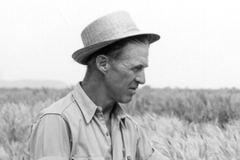
The Green Revolution Story
"The genes that sparked the Green Revolution came from unprepossessing wheat plants relegated to the ranks of agronomic curiosities. But their short, stiff straw and heavy seed heads caught the eye of ARS agronomist S. Cecil Salmon who was with Gen. Douglas MacArthur's headquarters in 1946 helping assess Japan's postwar agricultural problems. Salmon acquired seeds of 16 different strains including one named Norin No. 10 for the World Small Grain Collection in Beltsville, Md.
"Within a year, the Collection processed and distributed the seeds to various U.S. wheat breeders. Some went to ARS-Washington State University breeders in Pullman. The Pullman team, led by ARS plant breeder Orville Vogel, analyzed the seeds' initial progeny for strengths and weaknesses. Over the next 13 years the scientists made many hybrid crosses and selections. One of the wheat varieties that came out of these efforts was the famed short-strawed Gaines.
"While hybridization was underway, Norman E. Borlaug of the International Maize and Wheat Research Centre, Mexico, visited Pullman and was impressed with the short-stalked wheat's potential. The group shared germplasm with Borlaug who, in turn, crossed it with Mexico's best wheats.
"In 1963 Borlaug responded to an urgent request from the government of India to tour its major wheat-growing regions and provide breeders with lines containing Norin No. 10 dwarfing genes. The tall native wheats had encountered an insurmountable yield barrier. When heavily fertilized with nitrogen, they grew too high, became top-heavy, and lodged.
"Borlaug's semidwarf wheats enabled India to finally launch its Green Revolution. The combination of new genes, fertilizer, and irrigation spurred wheat production from 12 million metric tons in 1965 to over 20 million in 1970 and over 37 million last year. Since the new wheats were broadly adapted, Green Revolutions also took hold in countries sharing similar latitudes, such as Pakistan, Turkey, and Afghanistan. For his contributions, Borlaug was awarded the Nobel Prize.
"Arid regions of India also benefited from a Green Revolution, one based on hybrid pearl millets. But an obstacle to hybridization had to be overcome first because many grasses, including millets, self-pollinate. ARS geneticist Glenn Burton altered pearl millet's cytoplasm to create the cytoplasmic male-sterile plants that made hybrids possible. In 1961, Burton sent male-sterile millet seeds to India for its breeding programs. By 1965 the Indian scientists developed a new hybrid that out-yielded native varieties by 88 percent. In that year, India produced 3.5 million tons of millet. Just 5 years later, millet production climbed to 8 million tons. That gain in yield accounted for 20 percent of the extra food production in India's Green Revolution.
"Plant breeders rely on the collection and preservation of still-extant germplasm. A major effort is underway to save from extinction not only the seeds of plants now cultivated but also their wild relatives with rich and irreplaceable genetic qualities from resistance to disease and drought to higher yields. A wide variety of genetic material is essential if breeders are to improve and perpetuate the world's crops.
"Two internationally known facilities are maintained by ARS to help foster genetic diversity. The World Small Grain Collection, which can be traced to informal origins in the 1870's, serves as a 'working' collection. It collects, maintains, distributes, and evaluates germplasm to meet the ongoing needs of plant breeders everywhere. At present, the Collection maintains some 102,000 strains of wheat, barley, oats, rice, rye, and triticale.
"On the other hand, the National Seed Storage Laboratory (NSSL), Fort Collins, Colo., is a 'base' collection. It maintains, mostly in cold-storage rooms, over 200,000 separate collections of seed and vegetative stock. Some collections were obtained by expeditions to remote lands. Although the NSSL's germplasm may duplicate that in working collections, it releases material only when it is not available elsewhere. Its prime mission is to perpetually safeguard germplasm, an ultimate gene bank for the plant breeders working to help feed the world's burgeoning population." To learn more about Norman Borlaug and The Green Revolution, view "The Man Who Tried to Feed the World: A Tale of Good Deeds and Unintended Consequences."
Questions
What were some of the small discoveries that ultimately led to the great breakthrough that became the "green revolution?"
Do you think the scientists who made each of these small discoveries understood at the time the importance of their work? Why or why not?
Why is the work of these scientists referred to as a revolution?
What different career fields are mentioned in the story?
ARS Timeline: 138 Years of Ag Research, U.S. Department of Agriculture [online].

Criticism of the Green Revolution
Despite the good that has come from the Green Revolution, there have also been criticisms of its consequences. Review the "Green Revolution" information on the Wikipedia page and respond to the questions below.
Questions
What is biodiversity?
How can biodiversity be preserved?
How does the definition of sustainable agriculture conflict with the agriculture methods of the green revolution?
How might the goals of the green revolution be met through biodiversity?

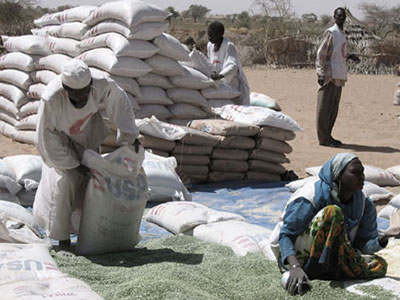
USAID
For many decades the United States has provided emergency relief supplies to other nations during times of crises through the United States Agency for International Development (USAID). This photograph shows Red Crescent workers in Sudan bagging green split peas for the people of Darfur, Sudan affected by civil war.
Questions
Why do you think the United States provides supplies to people in areas of the world where conflict is occurring?
How might the government's action in giving food to nations at war impact American agriculture?
What impact would it have on American agriculture if poorer nations, currently unable to feed themselves, become successful and efficient producers of food not only for their own people but also for export?

Copied url to clipboard!



